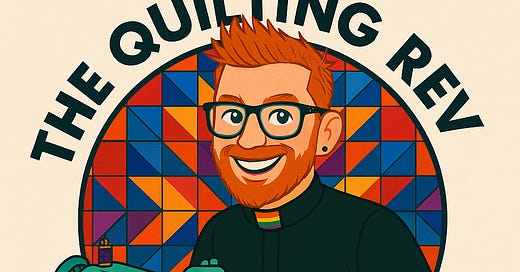Listen, I already posted once this week, but apparently my brain didn’t get the memo that one post was enough. Blame the coffee, brilliant quilting friends, and my chronic curiosity. So here we are, spiraling into why we quilters use words like material, fabric, and cloth like they’re all the same—except they’re totally not. This one’s just for fun, sparked by nerdy wonder and the belief that even our scraps have stories to tell. Buckle up, fiber friends—it’s time for a little linguistic joyride.
One of my quilty friends has a curiosity that could outpace a Google search on espresso and adrenaline. She has the kind of mind that sees a feather on the sidewalk and ends up researching the migratory habits of birds by region and season—then sends you a podcast and three articles about it, just because she thought you'd find it interesting. It’s not flashy or performative, but the kind of quiet, generative wonder that can spend an afternoon comparing the speckled pigments of bird eggs and somehow end up in a conversation about the sacredness of hand-quilting.
Lately, we’ve been deep in conversation about the nuances of things. The kind of conversation that starts with, say, the differences in the eggs that different birds lay and somehow leads to an exploration of language, texture, and meaning. One of those chats got me thinking about how we, as makers—and especially as quilters—talk about the very medium with which we make: material, fabric, and cloth.
To someone outside our world, these might sound interchangeable. Just synonyms. But for those of us who work with them, handle them, choose them carefully, hoard them sometimes, and cut into them with trembling precision—they’re not the same at all.
Material: The Stuff We Start With
Sometimes, at the quilt shop, I hear someone say, "I need to pick up some material." It’s a phrase that sounds casual, maybe even a little utilitarian. "Material" is often what people call it before it has a project attached to it—before it’s destined to be anything in particular. It might be a bolt of Kona cotton or a yard of novelty print. But at that point, it’s still open-ended. It hasn’t been claimed.
"Material" is the broadest of the three terms. It can mean wood, metal, stone, or yes, textile. It signals rawness. Potential. The unshaped substance from which something else will come. In a way, material is creation in its earliest, most tender form. It’s dust and breath. Chaos and light. A pile of scraps on your studio table before inspiration strikes.
It is, in theological terms, the stuff God speaks into. Material is what we’re made from, and what we make with.
Fabric: The Stuff with Structure
Then there’s fabric. Fabric is what we reach for when we know what we’re doing—or at least, when we’re trying to. It has structure. It has identity. It might be linen, chambray, lawn, or wool. It’s the warp and the weft, the weave, the stretch, the drape.
Fabric is not just about raw substance; it’s about integrity. A batik from Bali or a yard of Liberty is not just material to a quilter—it’s fabric, and that word implies respect. Investment. Relationship.
It’s not accidental that we talk about the "fabric of community," the "fabric of society." Fabric suggests something that holds together. Threads that are connected, intentionally and intricately. In theological language, maybe fabric is covenant. It is interconnection. Structure. The body of Christ, even—woven, stretched, sometimes torn, yet never unraveling completely.
Fabric is what you choose, match, audition. It’s full of possibility, but also commitment. Once you cut it, you're in.
Cloth: The Stuff with Purpose
And then there’s cloth. Cloth is something else entirely. It’s fabric with a calling. It’s fabric that has been used.
"Cloth" shows up in sacred and tender places. A communion cloth. A dishcloth. A shroud. A baby’s swaddle. A wedding dress. The ragged hem of something worn and beloved. Cloth has been touched, blessed, torn, mended, held.
When someone says, "That’s a beautiful cloth," they don’t usually mean yardage. They mean something embodied. Something with presence. Cloth carries story. It has a history. It has done something in the world.
Theologically, cloth might be incarnation. It is the Word made tactile. The veil torn. The hem grasped. The linen folded in the empty tomb. Cloth is not theoretical. It is real. It is love, made threadbare.
So what do we mean when we say we work with material, fabric, or cloth? Sometimes we use the words interchangeably. And that’s okay. But maybe next time, we pause to wonder what we’re really touching.
Maybe what we hold in our hands isn’t just textile. Maybe it’s a layered language of becoming.
Material is what we start with.
Fabric is what we build with.
Cloth is what we live with.
And maybe that’s why, as quilters, we can feel so much from a scrap basket.
It’s not just scraps. It’s memory. Mystery. Meaning. It’s material, fabric, cloth—waiting to become.




Oh, how you would have loved this year's PAM Worship and Music Conference. Clothed in Love.